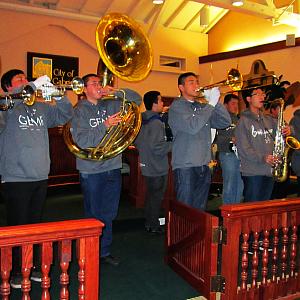
Members of the Gabrielino Eagle Marching Regiment perform at San Gabriel’s first City Council meeting for 2013. – Photo by Jim E. Winburn
The proposed CDBG budget funding request is $318,433, and a public hearing was held to receive comments on the proposed program and budget plan, but no one from the public responded at the meeting.
The proposed 2013-14 program allocation has been reduced by 7 percent to reflect changes in the city’s population from the 2010 national census data, according to the staff report.
This represents a reduction in 53 percent due to a decrease in both federal funding and the last adjustment to national census data for the city – when San Gabriel received a CDBG allocation of $670,234 in FY 2001-02.
“The trend in continuous yearly reductions raises uncertainty about the CDBG as a reliable funding source for cities and communities across the nation,” staff wrote in its report.
The spending of CDBG money must comply with a 15 percent cap on public services that will benefit low- and moderate-income residents. In addition, 70 percent of the city’s CDBG funds must be used for programs that benefit low- and moderate-income households, jobs, as well as slum-blight area designations.
The proposed CDBG budget exceeds these minimum requirements, according to staff.
The council approved CDBG funds to be used for programs that include residential code enforcement, graffiti removal, the San Gabriel Boulevard Streetscape Improvement Project, and to continue youth programs.
The proposed funding reduction to San Gabriel’s upcoming CDBG program will result in a reduction of staffing levels in the Neighborhood Improvement Services division of the Community Development Department – unless City General Funds are used to support NIS to maintain its current levels, according to the report.
However, staff note that the reduction in funds will not affect city staffing levels for the graffiti removal program because the city contracts with an outside vendor to remove graffiti on public and private property in residential and neighborhood commercial properties.
Youth programs will remain in tact but may be affected by the budget reductions, resulting in a reduction in program hours overall. The report noted the possible elimination of the Dewey Avenue Elementary School summer program depending on participation.
“Why Dewey, and is there a backup plan for those kids at the school for the summer?” Councilwoman Juli Costanzo asked at the meeting.
Nancy Hogan, acting director of Parks and Recreation responded, saying, “I think the reason Dewey was singled out was because attendance was so low compared to our other programs.”
Hogan said that it didn’t make sense to allocate staff time for 12-15 kids when compared to “putting somebody at Smith Park where we have 70-80 kids.”
The report also noted that Dewey Elementary School students may also be served by the free after school program offered by Woodcraft Rangers.
The city also expects to receive $21,369 in after school program funds from Los Angeles County Supervisor Michael D. Antonovich this year – once those funds are approved by the Board of Supervisors.
San Gabriel receives the federal Community Development Block Grant funds as a participating jurisdiction through the county’s Community Development Commission (CDC) from the U.S. Housing and Urban Development Department (HUD).

